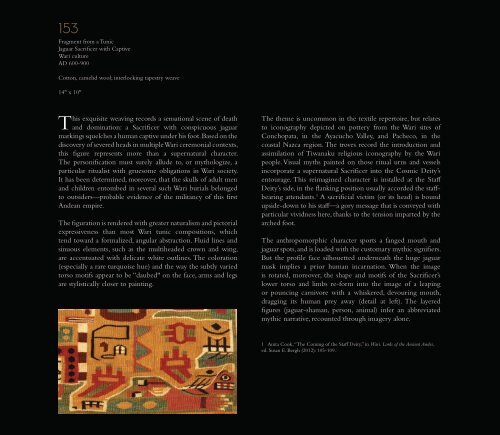Create successful ePaper yourself
Turn your PDF publications into a flip-book with our unique Google optimized e-Paper software.
153<br />
Fragment from a Tunic<br />
Jaguar Sacrificer with Captive<br />
Wari culture<br />
AD 600-900<br />
Cotton, camelid wool; interlocking tapestry weave<br />
14" x 10"<br />
This exquisite weaving records a sensational scene of death<br />
and domination: a Sacrificer with conspicuous jaguar<br />
markings squelches a human captive under his foot. Based on <strong>the</strong><br />
discovery of severed heads in multiple Wari ceremonial contexts,<br />
this figure represents more than a supernatural character.<br />
The personification must surely allude to, or mythologize, a<br />
particular ritualist with gruesome obligations in Wari society.<br />
It has been determined, moreover, that <strong>the</strong> skulls of adult men<br />
and children entombed in several such Wari burials belonged<br />
to outsiders—probable evidence of <strong>the</strong> militancy of this first<br />
Andean empire.<br />
The figuration is rendered with greater naturalism and pictorial<br />
expressiveness than most Wari tunic compositions, which<br />
tend toward a formalized, angular abstraction. Fluid lines and<br />
sinuous elements, such as <strong>the</strong> multiheaded crown and wing,<br />
are accentuated with delicate white outlines. The coloration<br />
(especially a rare turquoise hue) and <strong>the</strong> way <strong>the</strong> subtly varied<br />
torso motifs appear to be “daubed" on <strong>the</strong> face, arms and legs<br />
are stylistically closer to painting.<br />
The <strong>the</strong>me is uncommon in <strong>the</strong> textile repertoire, but relates<br />
to iconography depicted on pottery from <strong>the</strong> Wari sites of<br />
Conchopata, in <strong>the</strong> Ayacucho Valley, and Pacheco, in <strong>the</strong><br />
coastal Nazca region. The troves record <strong>the</strong> introduction and<br />
assimilation of Tiwanaku religious iconography by <strong>the</strong> Wari<br />
people. Visual myths painted on those ritual urns and vessels<br />
incorporate a supernatural Sacrificer into <strong>the</strong> Cosmic Deity’s<br />
entourage. This reimagined character is installed at <strong>the</strong> Staff<br />
Deity’s side, in <strong>the</strong> flanking position usually accorded <strong>the</strong> staffbearing<br />
attendants. 1 A sacrificial victim (or its head) is bound<br />
upside-down to his staff—a gory message that is conveyed with<br />
particular vividness here, thanks to <strong>the</strong> tension imparted by <strong>the</strong><br />
arched foot.<br />
The anthropomorphic character sports a fanged mouth and<br />
jaguar spots, and is loaded with <strong>the</strong> customary mythic signifiers.<br />
But <strong>the</strong> profile face silhouetted underneath <strong>the</strong> huge jaguar<br />
mask implies a prior human incarnation. When <strong>the</strong> image<br />
is rotated, moreover, <strong>the</strong> shape and motifs of <strong>the</strong> Sacrificer’s<br />
lower torso and limbs re-form into <strong>the</strong> image of a leaping<br />
or pouncing carnivore with a whiskered, devouring mouth,<br />
dragging its human prey away (detail at left). The layered<br />
figures (jaguar-shaman, person, animal) infer an abbreviated<br />
mythic narrative, recounted through imagery alone.<br />
1 Anita Cook, “The Coming of <strong>the</strong> Staff Deity,” in Wari. Lords of <strong>the</strong> <strong>Ancient</strong> <strong>Andes</strong>,<br />
ed. Susan E. Bergh (2012): 105-109.<br />
60







